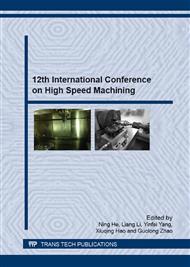[1]
M. Toolabi, A.S. Fallah, P.M. Baiz, L.A. Louca, Dynamic analysis of a viscoelastic orthotropic cracked body using the extended finite element method, Engineering Fracture Mechanics 109(2013) 17-32.
DOI: 10.1016/j.engfracmech.2013.06.003
Google Scholar
[2]
Z.Y. Wang, L. Ma, L.Z. Wu, H.J. Yu, Numerical simulation of crack growth in brittle matrix of particle reinforced composites using the XFEM technique, Acta Mechanica Solida Sinica. 25(2012) 9-21.
DOI: 10.1016/s0894-9166(12)60002-0
Google Scholar
[3]
B.X. Xu, X. Chen, H. Waisman, Crack propagation toward a desired path by controlling the force direction, Engineering Fracture Mechanics 76(2009) 2554-2559.
DOI: 10.1016/j.engfracmech.2009.09.007
Google Scholar
[4]
X.Z. Su, Z.J. Yang, G.H. Liu, Finite Element Modelling of complex 3D static and dynamic crack propagation by embedding cohesive elements in Abaqus, Acta Mechanica Solida Sinica. 23 (2010) 271-282.
DOI: 10.1016/s0894-9166(10)60030-4
Google Scholar
[5]
B.N. Kim, S. Wakayama, Simulation of microfracture process of brittle polycrystals: Microcracking and crack propagation, Computational Materials Science 8 (1997) 327-334.
DOI: 10.1016/s0927-0256(97)00045-1
Google Scholar
[6]
P.D. Zavattieri, H.D. Espinosa, Grain level analysis of crack initiation and propagation in brittle materials, Acta Mater. 49 (2001) 4291-4311.
DOI: 10.1016/s1359-6454(01)00292-0
Google Scholar
[7]
T.T. Zhou, Simulation study on nano-scale interfaction behavior and micro-scale fracture behavior of ceramic tool materials, Shandong University (2012).
Google Scholar
[8]
R. Quey, P.R. Dawson, F. Barbe, Large-scale 3D random polycrystals for the finite element method: Generation, meshing and remeshing, Comput. Methods Appl. Mech. Engrg. 200 (2011) 1729-1745.
DOI: 10.1016/j.cma.2011.01.002
Google Scholar
[9]
R.H. Kraft, J.F. Molinari, A statistical investigation of the effects of grain boundary properties on transgranular fracture, Acta Materialia 56 (2008) 4739-4749.
DOI: 10.1016/j.actamat.2008.05.036
Google Scholar
[10]
H.D. Espinosa, P.D. Zavattieri, A grain level model for the study of failure initiation and evolution in polycrystalline brittle materials. Part II: Numerical examples, Mechanics of Materials 35 (2003) 365-394.
DOI: 10.1016/s0167-6636(02)00287-9
Google Scholar
[11]
S. Jiao, M.L. Jenkins, R.W. Davidge, Interfacial fracture energy-mechanical behaviour relationship in Al2O3/SiC and Al2O3/TiN nanocomposites, Acta Materi. 45(1997) 149-156.
DOI: 10.1016/s1359-6454(96)00168-1
Google Scholar
[12]
R. P. Wahi, B. Ilschner, Fracture behaviour of composites based on Al2O3-TiC, Journal of Materials Science 15 (1980). 875-885.
DOI: 10.1007/bf00552097
Google Scholar


